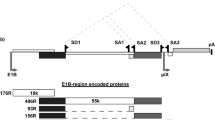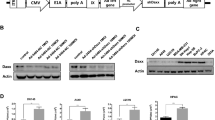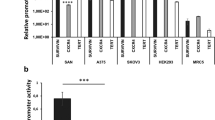Abstract
While the mammalian orthoreovirus type 3 dearing (reovirus T3D) infects many different tumour cells, various cell lines resist the induction of reovirus-mediated cell death. In an effort to increase the oncolytic potency, we introduced transgenes into the S1 segment of reovirus T3D. The adenovirus E4orf4 gene was selected as transgene since the encoded E4orf4 protein induces cell death in transformed cells. The induction of cell death by E4orf4 depends in part on its binding to phosphatase 2A (PP2A). In addition to the S1-E4orf4 reovirus, two other reoviruses were employed in our studies. The reovirus rS1-RFA encodes an E4orf4 double-mutant protein that cannot interact with PP2A and the rS1-iLOV virus encoding the fluorescent marker iLOV as a reporter. The replacement of the codons for the junction adhesion molecule-A (JAM-A) binding head domain of the truncated spike protein blocks the entry of these recombinant viruses via the reovirus receptor JAM-A. Instead these viruses rely on internalization via binding to sialic acids on the cell surface. This expands their tropism and allows infection of JAM-A-deficient tumour cells. Here we not only demonstrate the feasibility of this approach but also established that the cytolytic activity of these recombinant viruses is largely transgene independent.
This is a preview of subscription content, access via your institution
Access options
Subscribe to this journal
Receive 12 print issues and online access
$259.00 per year
only $21.58 per issue
Buy this article
- Purchase on SpringerLink
- Instant access to full article PDF
Prices may be subject to local taxes which are calculated during checkout





Similar content being viewed by others
References
Fernández-Medarde A, Santos E. Ras in cancer and developmental diseases. Genes Cancer. 2011;2:344–58.
Shin SM, Choi DK, Jung K, Bae J, Kim JS, Park SW, et al. Antibody targeting intracellular oncogenic Ras mutants exerts anti-tumour effects after systemic administration. Nat Commun. 2017;8:15090.
Smakman N, Van Den Wollenberg DJM, Borel Rinkes IHM, Hoeben RC, Kranenburg O. Sensitization to apoptosis underlies KrasD12-dependent oncolysis of murine C26 colorectal carcinoma cells by reovirus T3D. J Virol. 2005;79:14981–5.
Marcato P, Shmulevitz M, Pan D, Stoltz D, Lee PWK. Ras transformation mediates reovirus oncolysis by enhancing virus uncoating, particle infectivity, and apoptosis-dependent release. Mol Ther. 2007;15:1522–30.
Zhao X, Chester C, Rajasekaran N, He Z, Kohrt HE. Strategic combinations: the future of oncolytic virotherapy with reovirus. Mol Cancer Ther. 2016;15:767–73.
Gong J, Sachdev E, Mita AC, Mita MM. Clinical development of reovirus for cancer therapy: an oncolytic virus with immune-mediated antitumor activity. World J Methodol. 2016;6:25–42.
Twigger K, Roulstone V, Kyula J, Karapanagiotou EM, Syrigos KN, Morgan R, et al. Reovirus exerts potent oncolytic effects in head and neck cancer cell lines that are independent of signalling in the EGFR pathway. BMC Cancer. 2012;12:368.
Kim M, Egan C, Alain T, Urbanski SJ, Lee PW, Forsyth PA, et al. Acquired resistance to reoviral oncolysis in Ras-transformed fibrosarcoma cells. Oncogene. 2007;26:4124–34.
van den Wollenberg DJ, Dautzenberg IJ, Ros W, Lipinska AD, van den Hengel SK, Hoeben RC. Replicating reoviruses with a transgene replacing the codons for the head domain of the viral spike. Gene Ther. 2015;22:51–63.
Eaton HE, Kobayashi T, Dermody TS, Johnston RN, Jais PH, Shmulevitz M. African swine fever virus NP868R capping enzyme promotes reovirus rescue during reverse genetics by promoting reovirus protein expression, virion assembly, and RNA incorporation into infectious virions. J. Virol. 2017; 91:e02416-16
Van Den Wollenberg DJM, Dautzenberg IJC, Van Den Hengel SK, Cramer SJ, De Groot RJ, Hoeben RC. Isolation of reovirus T3D mutants capable of infecting human tumor cells independent of junction adhesion molecule-A. PLoS ONE. 2012;7:e48064.
Marcellus RC, Chan H, Paquette D, Thirlwell S, Boivin D, Branton PE. Induction of p53-independent apoptosis by the adenovirus E4orf4 protein requires binding to the Balpha subunit of protein phosphatase 2A. J Virol. 2000;74:7869–77.
Branton PE, Roopchand DE. The role of adenovirus E4orf4 protein in viral replication and cell killing. Oncogene. 2001;20:7855–65.
Livne A, Shtrichman R, Kleinberger T. Caspase activation by adenovirus e4orf4 protein is cell line specific and Is mediated by the death receptor pathway. J Virol. 2001;75:789–98.
Janssens V, Goris J. Protein phosphatase 2A: a highly regulated family of serine/threonine phosphatases implicated in cell growth and signalling. Biochem J. 2001;353(Pt 3):417–39.
Brestovitsky A, Sharf R, Mittelman K, Kleinberger T. The adenovirus E4orf4 protein targets PP2A to the ACF chromatin-remodeling factor and induces cell death through regulation of SNF2h-containing complexes. Nucleic Acids Res. 2011;39:6414–27.
Champagne C, Landry MC, Gingras MC, Lavoie JN. Activation of adenovirus type 2 early region 4 ORF4 cytoplasmic death function by direct binding to Src kinase domain. J Biol Chem. 2004;279:25905–15.
Miron MJ, Blanchette P, Groitl P, Dallaire F, Teodoro JG, Li S, et al. Localization and importance of the adenovirus E4orf4 protein during lytic infection. J Virol. 2009;83:1689–99.
Oberhaus SM, Dermody TS, Tyler KL. Apoptosis and the cytopathic effects of reovirus. Curr Top Microbiol Immunol. 1998;233(Pt 2):23–49.
Connolly JL, Dermody TS. Virion disassembly is required for apoptosis induced by reovirus. J Virol. 2002;76:1632–41.
Richardson-Burns SM, Kominsky DJ, Tyler KL. Reovirus-induced neuronal apoptosis is mediated by caspase 3 and is associated with the activation of death receptors. J Neurovirol. 2002;8:365–80.
Clarke P, Richardson-Burns SM, DeBiasi RL, Tyler KL. Mechanisms of apoptosis during reovirus infection. Curr Top Microbiol Immunol. 2005;289:1–24.
Danthi P, Hansberger MW, Campbell JA, Forrest JC, Dermody TS. JAM-A-independent, antibody-mediated uptake of reovirus into cells leads to apoptosis. J Virol. 2006;80:1261–70.
Dionne KR, Zhuang Y, Leser JS, Tyler KL, Clarke P. Daxx upregulation within the cytoplasm of reovirus-infected cells is mediated by interferon and contributes to apoptosis. J Virol. 2013;87:3447–60.
Berger AK, Danthi P. Reovirus activates a caspase-independent cell death pathway. mBio. 2013;4:e00178–13.
Simon EJ, Howells MA, Stuart JD, Boehme KW. Serotype-specific killing of large cell carcinoma cells by reovirus. Viruses. 2017; 9:v9060140
Hiller BE, Berger AK, Danthi P. Viral gene expression potentiates reovirus-induced necrosis. Virology. 2015;484:386–94.
Li S, Szymborski A, Miron MJ, Marcellus R, Binda O, Lavoie JN, et al. The adenovirus E4orf4 protein induces growth arrest and mitotic catastrophe in H1299 human lung carcinoma cells. Oncogene. 2009;28:390–400.
Terasawa Y, Hotani T, Katayama Y, Tachibana M, Mizuguchi H, Sakurai F. Activity levels of cathepsins B and L in tumor cells are a biomarker for efficacy of reovirus-mediated tumor cell killing. Cancer Gene Ther. 2015;22:188–97.
Galanis E, Markovic SN, Suman VJ, Nuovo GJ, Vile RG, Kottke TJ, et al. Phase II trial of intravenous administration of reolysin(®) (reovirus serotype-3-dearing strain) in patients with metastatic melanoma. Mol Ther. 2012;20:1998–2003.
Karapanagiotou EM, Roulstone V, Twigger K, Ball M, Tanay M, Nutting C, et al. Phase I/II trial of carboplatin and paclitaxel chemotherapy in combination with intravenous oncolytic reovirus in patients with advanced malignancies. Clin Cancer Res. 2012;18:2080–9.
Wold WS, Toth K. Adenovirus vectors for gene therapy, vaccination and cancer gene therapy. Curr Gene Ther. 2013;13:421–33.
Schiza A, Wenthe J, Mangsbo S, Eriksson E, Nilsson A, Totterman TH, et al. Adenovirus-mediated CD40L gene transfer increases Teffector/Tregulatory cell ratio and upregulates death receptors in metastatic melanoma patients. J Transl Med. 2017;15:79.
Van Den Wollenberg DJM, Van Den Hengel SK, Dautzenberg IJC, Cramer SJ, Kranenburg O, Hoeben RC. A strategy for genetic modification of the spike-encoding segment of human reovirus T3D for reovirus targeting. Gene Ther. 2008;15:1567–78.
Parsons SJ, Parsons JT. Src family kinases, key regulators of signal transduction. Oncogene. 2004;23:7906–9.
Robert A, Miron M-J, Champagne C, Gingras M-C, Branton PE, Lavoie JN. Distinct cell death pathways triggered by the adenovirus early region 4 ORF 4 protein. J Cell Biol. 2002;158:519–28.
Kim M, Garant KA, zur Nieden NI, Alain T, Loken SD, Urbanski SJ, et al. Attenuated reovirus displays oncolysis with reduced host toxicity. Br J Cancer. 2011;104:290–9.
Connolly JL, Barton ES, Dermody TS. Reovirus binding to cell surface sialic acid potentiates virus-induced apoptosis. J Virol. 2001;75:4029–39.
Roner MR, Roehr J. The 3' sequences required for incorporation of an engineered ssRNA into the reovirus genome. Virol J. 2006;3:1743-422x-3-1
Fallaux FJ, Kranenburg O, Cramer SJ, Houweling A, van Ormondt H, Hoeben RC, et al. Characterization of 911: a new helper cell line for the titration and propagation of early region 1-deleted adenoviral vectors. Hum Gene Ther. 1996;7:215–22.
Pereg Y, Shkedy D, de Graaf P, Meulmeester E, Edelson-Averbukh M, Salek M, et al. Phosphorylation of Hdmx mediates its Hdm2- and ATM-dependent degradation in response to DNA damage. Proc Natl Acad Sci USA. 2005;102:5056–61.
Buijs JT, Rentsch CA, van der Horst G, van Overveld PGM, Wetterwald A, Schwaninger R, et al. BMP7, a putative regulator of epithelial homeostasis in the human prostate, is a potent inhibitor of prostate cancer bone metastasis in vivo. Am J Pathol. 2007;171:1047–57.
Buchholz UJ, Finke S, Conzelmann K-K. Generation of bovine respiratory syncytial virus (BRSV) from cDNA: BRSV NS2 is not essential for virus replication in tissue culture, and the human RSV leader region acts as a functional BRSV genome promoter. J Virol. 1999;73:251–9.
Roner MR, Steele BG. Features of the mammalian orthoreovirus 3 Dearing l1 single-stranded RNA that direct packaging and serotype restriction. J Gen Virol. 2007;88:3401–12.
Kobayashi T, Antar AAR, Boehme KW, Danthi P, Eby EA, Guglielmi KM, et al. A plasmid-based reverse genetics system for animal double-stranded RNA viruses. Cell Host Microbe. 2007;1:147–57.
Kobayashi T, Ooms LS, Ikizler M, Chappell JD, Dermody TS. An improved reverse genetics system for mammalian orthoreoviruses. Virology. 2010;398:194–200.
Acknowledgements
We would like to thank Dr. Philip Branton for providing us with the plasmid pcDNA3-FLAG-B55a that we used for generating the 911-Flag.PP2A cell line. We are grateful to Dr. Geertje van der Horst (LUMC, Department of Urology) for providing the PC-3M-Pro4/Luc and UMUC-3 cell lines and Dr. Ruud Verrijk (Dr. Reddy’s Research & Development, Leiden, The Netherlands) for discussions on statistical methods. Also the Forensic Laboratory for DNA Research, of the LUMC department of Human Genetics is gratefully acknowledged for STR analyses of the human cell lines.
Author information
Authors and Affiliations
Corresponding author
Ethics declarations
Conflict of interest
The authors declare that they have no conflict of interest.
Electronic supplementary material
Rights and permissions
About this article
Cite this article
Kemp, V., Dautzenberg, I.J.C., Cramer, S.J. et al. Characterization of a replicating expanded tropism oncolytic reovirus carrying the adenovirus E4orf4 gene. Gene Ther 25, 331–344 (2018). https://doi.org/10.1038/s41434-018-0032-9
Received:
Revised:
Accepted:
Published:
Issue Date:
DOI: https://doi.org/10.1038/s41434-018-0032-9



